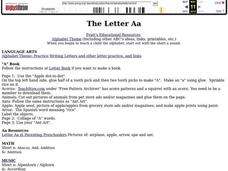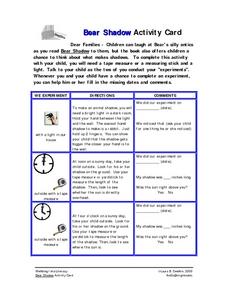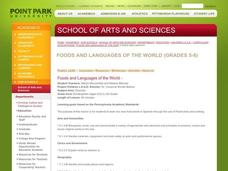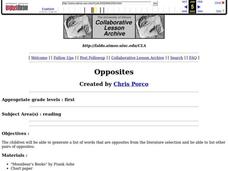Curated OER
The Giving Tree
Young scholars investigate the virtue of kindness and giving by conducting a children's literature study of "The Giving Tree". They make a list of words to describe emotions in the story and write a journal daily while looking at the...
Curated OER
Our Global Community
First graders experience literature which shows how communities live around the world. In this global community activity, 1st graders read books such as Whoever You Are, by Mem Fox and create a work of art based on their feelings about...
Curated OER
"All Day Nightmare"
Students read an "All Day Nightmare" by R.L. Stine. They use the interactive book to choose the plot at the end of each chapter. They also complete an open-ended story.
Curated OER
Me on the Map: Homes, Neighborhoods, and Communities
Students read a book about maps and identify the differences between a picture and a map. In this maps lesson plan, students also label maps of their home, neighborhood, and community.
Curated OER
Making the World a More Beautiful Place
Students discover how they can contribute in a positive manner in their community. In this service learning lesson, students experience literature through the lens of responsible citizenship.
Curated OER
Families and Neighborhoods
Students investigate the characteristics of a neighborhood. In this communities instructional activity, students read the book Franklin's Neighborhood and list people and places in their community. Students create a neighborhood mural.
Curated OER
The Letter Ww
Students explore letter Ww. In this letter recognition lesson, students participate in country, state, food, literature, physical education, colors, careers, music, and game activities that are linked to the main lesson page. Students...
Orange County Department of Education
The True Story of Abbie Burgess
First graders read a story about Abbie Burgess. They identify at least three specific actions exhibiting traits of courage and responsibility. Students explore ways children and adults become heroes by helping others out in a time of...
Curated OER
America the Beautiful
Students listen to story America the Beautiful, discuss places in America they have visited, define beautiful, and create and illustrate class book with pictures and words from song, America the Beautiful.
Curated OER
Kwanzaa: An African-American Heritage Celebration
Learners explain some of the symbols of Kwanzaa. They demonstrate their understanding of Kwanzaa by making a book about what they have learned.
Curated OER
Where Is Japan? What Direction Is It?
First graders locate countries on maps and globes and learn about the hemispheres and the cardinal directions. They listen to books read out loud and dicuss geography.
Curated OER
The Letter Aa
Students explore letter Aa. In this letter recognition instructional activity, students participate in country, state, food, literature, physical education, colors, careers, music, and game activities that are linked to the main...
Curated OER
"Bear Shadow" Activity Card
In this literature and science worksheet, students listen to a family member as they read "Bear Shadow." They conduct experiments that with light, shadows, and measuring tools before recording the date they did the experiment. They...
Curated OER
The Letter Cc
Learners explore letter Cc. In this letter recognition lesson, students participate in country, state, food, literature, physical education, colors, careers, music, and game activities that are linked to the main lesson page. Learners...
Curated OER
Sky 2: Shadows
students will explore making shadows and tracking the movement of an object over the course of a day to look for patterns. It is best to couple this shadow activity with reading the book, Bear Shadow, and making a map of Bear's...
Curated OER
Character Traits
First graders identify the story elements in stories. In this story element lesson, 1st graders read The Tale of Peter Rabbit by Beatrix Potter and they identify the characters, character traits, setting, problem, and solution. They...
Curated OER
The Horrible No Good Very Bad Day
First graders read Alexander and the Terrible Horrible No Good Very Bad Day, write sentence or paragraph about their experience with a bad day, and combine their work with that of classmates to create class book.
Curated OER
Ants Have Feelings, Too!
Learners consider how they show respect for others. In this service learning lesson, students listen and respond to literature from different perspectives.
Curated OER
We Are Alike, We Are Different:A Focus on Japan
First graders develop a connection with students in a first grade classroom in Japan. They begin to develop a curiosity about Japan--the landscape, the people, and their culture, while developing an understanding of the Five Themes of...
Curated OER
Foods and Languages of the World
Young scholars review Mexico's location and language and learn to pronouns 10 new Spanish food words. Students listen as the book, Corn is Maize is read, touching and passing around an ear of Indian corn. Young scholars discuss the...
Curated OER
The History of Maple Syrup
Students explore the process of harvesting maple syrup. In this science and history lesson, students make their own maple syrup and create a picture book that shows the Native American and American pioneer methods of making the syrup.
Curated OER
Our Five Senses Affect Food Choices
Students read My Five Senses: A Lion's Tale. In this five senses instructional activity, students understand the relationship between their five senses and how they affect their food choices. Students write journal entries about their...
Curated OER
Differences Between Fiction And Non-Fiction in the Library
Students examine the differences between fiction and non-fiction books in the library by discussing kangaroos. They distinguish between facts about kangaroos, and using their imaginations and imagining what they would do with pet kangaroos.
Curated OER
Opposites
First graders take a picture walk through of the big book "Moonbear's Books" and make predictions on what they think is happening. Echo read to check predictions. Students generate words that are opposites on chart paper.























